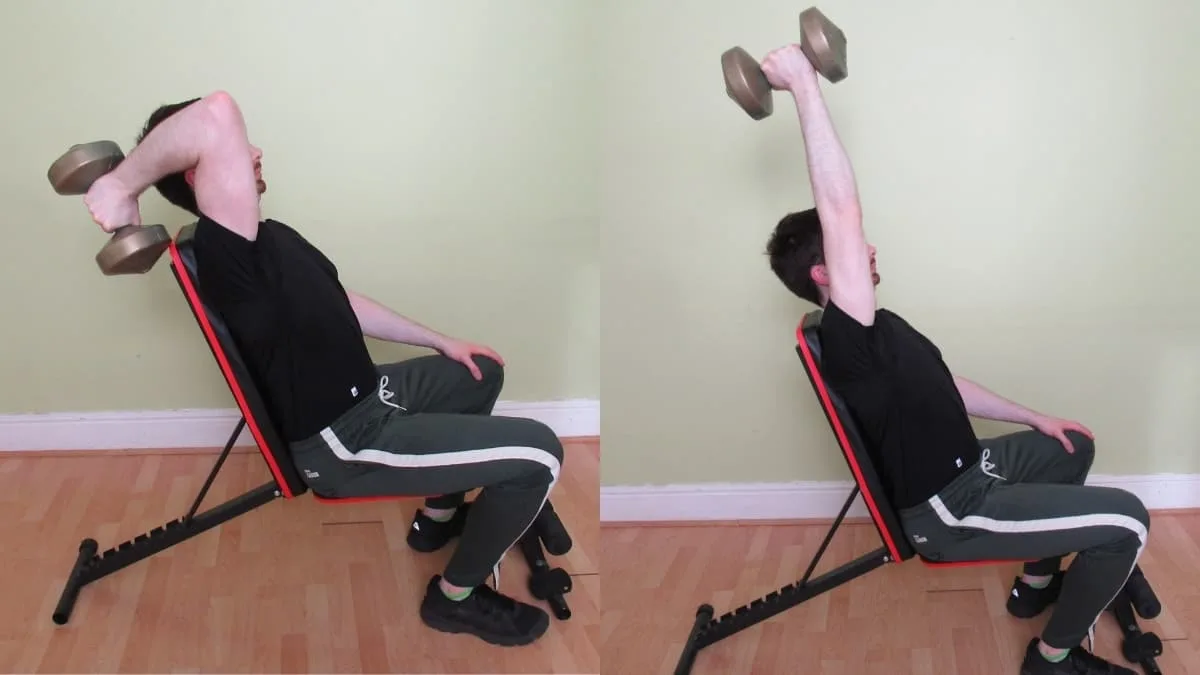The dumbbell overhead tricep extension is an effective exercise because it hits all three heads of the triceps and emphasizes the biggest of these three heads, the long head. This naturally makes the overhead extension a great exercise for building bigger arms because the triceps account for around two-thirds of your upper arm mass.
Yet, you can make tricep extensions even more effective by doing them seated and in a unilateral fashion.
This article shows you how to do a one arm seated dumbbell extension with the optimal tricep-building technique. Then we’ll explore the effectiveness of the seated tricep extension as well as the number of reps and sets that you should perform for hypertrophy.
One arm seated dumbbell extension exercise details
- Also Known As: Seated unilateral dumbbell extension
- Main Muscles: Triceps brachii
- Exercise Type: Strength
- Exercise Mechanics: Isolation
- Difficulty Level: Intermediate
- Equipment Needed: Dumbbell, bench
How to do a seated one arm overhead dumbbell extension
- Set the back pad of an adjustable bench to a 90-degree angle. You can also use a bench with a fixed backrest for more convenience.
- Grab a dumbbell, and then sit on the bench with your back braced against the pad.
- Press the dumbbell over your head and tuck your elbow in slightly.
- Lower the weight behind your head by breaking at your elbow.
- Keep going until your forearm touches your biceps (at which point you should feel a strong stretch in the back of your arm).
- Reverse the movement by flexing your triceps forcefully until your elbow reaches full extension.
- Perform 3-5 sets of 10-20 reps.
Is the seated one arm extension effective?
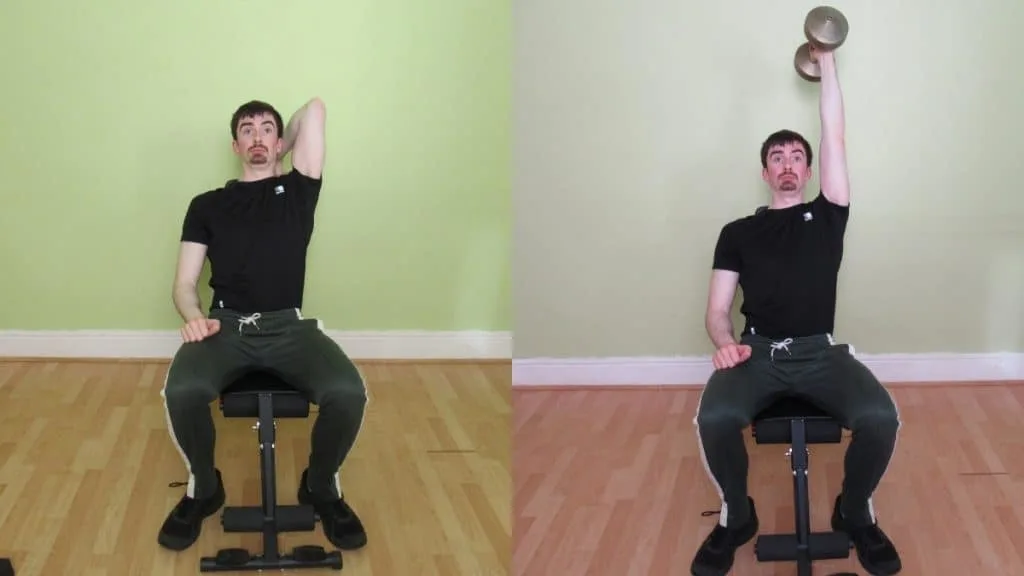
Like the seated BB extension, the seated single arm tricep extension is effective because it helps you to better isolate your triceps by reducing the core stability requirement of the exercise.
Since your torso is stabilized by the backrest of the bench, you don’t need to brace your abs so hard in order to keep your torso straight. This means that you can channel all of your energy and focus into training your triceps, which, after all, is the one and only purpose of a tricep isolation exercise.
Of course, performing your exercises in a standing position burns more calories and gives your abs a decent isometric workout in the process.
But it’s not like you can’t train your abs with other exercises.
And besides, from a hypertrophy perspective, seated exercises like the sitting one arm dumbbell tricep extension are usually superior to their standing counterparts because they enable you to more easily keep tension on the target muscles.
Similarly, because you’re performing the exercise in a unilateral fashion, which is to say, working one arm at a time, you don’t have to split your focus over two limbs. Since it’s easier for your brain to move one arm than two arms, you’ll naturally be able to lift a bit more weight when you train your triceps unilaterally because the working arm gets the full benefit of your central nervous system’s resources.
Who should do the seated one dumbbell triceps extension?

Since you have to lift each weight separately during the seated DB one arm extension, the exercise is ideal for those with triceps size asymmetries because your stronger triceps muscle can’t dominate the movement.
Of course, you might still have a better mind-muscle connection with one of your triceps, in which case that muscle would still get a better workout. But this disparity in mind-muscle connection is precisely what the seated one-arm overhead dumbbell extension can help to correct.
While unilateral exercises like the seated one arm extension certainly take longer to perform due to the fact that you’re doubling the number of sets, the benefit of more symmetrical triceps may well be worth the extra gym time if you have muscular imbalances.
But even if you don’t go to the gym, one arm seated dumbbell extensions are still a great exercise because they require nothing other than a single dumbbell.
If you were to perform the two-arm version, on the other hand, then you’d need access to a much heavier dumbbell, which isn’t always practical if you train at home.
Like front to back tricep extensions, the seated one arm dumbbell extension is highly convenient in this regard because, since you’re training unilaterally, you can get great results from lifting a relatively light dumbbell.
How many reps and sets should you perform?
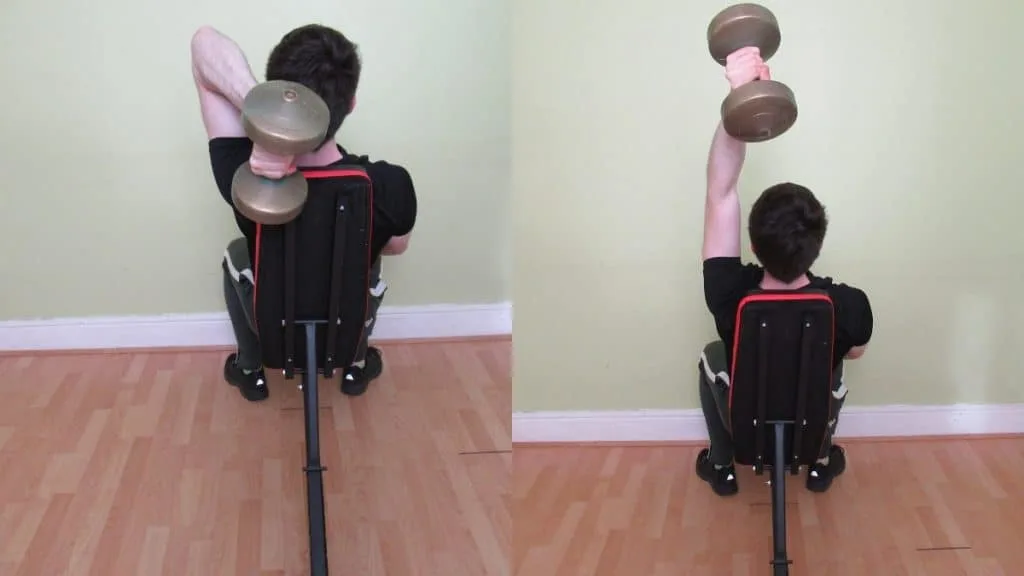
The one arm seated overhead tricep extension works at any rep range. After all, your triceps can’t tell how much weight you’re lifting or how many reps you’re performing—they’re just pieces of meat.
Still, most lifters get great results from performing the seated one arm tricep extension for moderate reps (8-15).
Lifting heavier weights for lower repetitions works well because the triceps brachii has a high proportion of fast-twitch muscle fibers. The problem is that heavy weights and tricep isolation exercises don’t usually mix; muscles can take far more of a beating than joints.
Doing more repetitions with a lighter weight also produces good gains and certainly maximizes your muscle pump due to the massive influx of metabolites that such a training style creates.
However, performing 20 reps and above on each set is extremely fatiguing. Once the systemic fatigue starts to accumulate, then your subsequent sets will suffer because you’ll be exhausted from doing so many reps.
For these reasons, performing 3-5 sets of 8-15 reps is the best bet for most people. In this rep range, you won’t become so tired that you feel like leaving the gym. But you’ll also be lifting heavy enough to where you’re recruiting the type 2 (fast-twitch) muscle fibers.
Are there similar exercises that produce results?
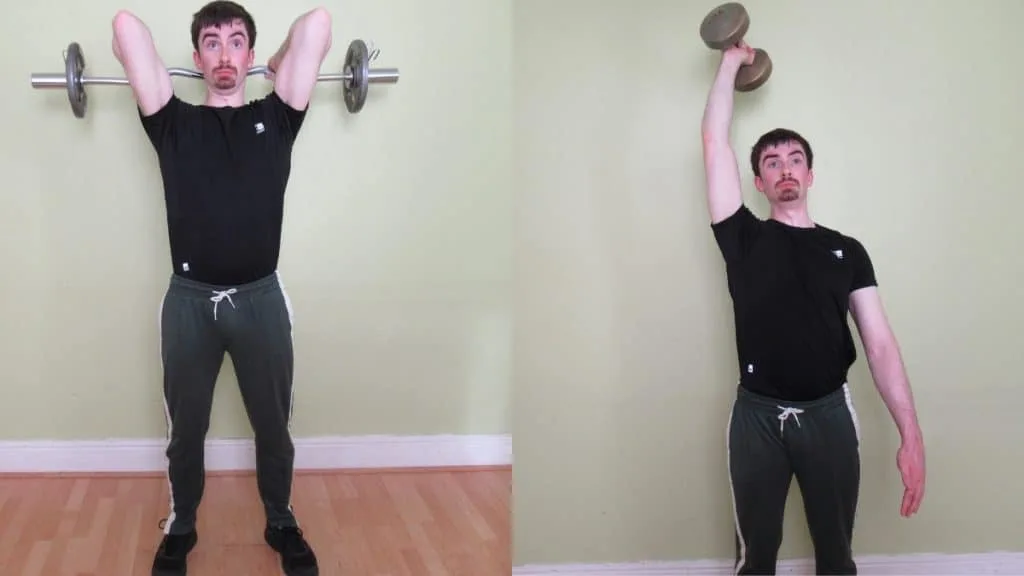
Getting results from your hard work in the gym obviously requires an appropriate, protein and nutrient-rich diet and good recovery.
As far as stimulating hypertrophy goes, however, there are similarly effective exercises in addition to the seated one dumbbell triceps extension.
The cable single arm overhead tricep extension challenges your muscles with constant tension, which naturally results in a potent pump. Unlike with the dumbbell one arm seated triceps extension, your muscles can’t rest at any point during the set when you use cables because the pulley is constantly exerting some kind of force on your triceps.
You can also perform the two-arm seated cable triceps extension if you’re in a hurry and want to save time. Using the rope attachment enables you to work each of your triceps fairly equally without having to perform twice as many sets.
The standing single arm overhead tricep extension is another good exercise and one which is very similar to the seated single arm tricep extension. Since this movement doesn’t require a bench, however, it’s more convenient than the seated version for those who train at home. The drawback (depending on your point of view) is that the standing variation requires greater abdominal exertion in order to keep your torso straight.
Overhead reverse grip triceps extensions are another common exercise and are certainly effective for developing the triceps. But since the triceps aren’t affected in any way by your wrist position, using a reverse grip often just makes it harder to hold the weight, which usually means lifting lighter.
In conclusion
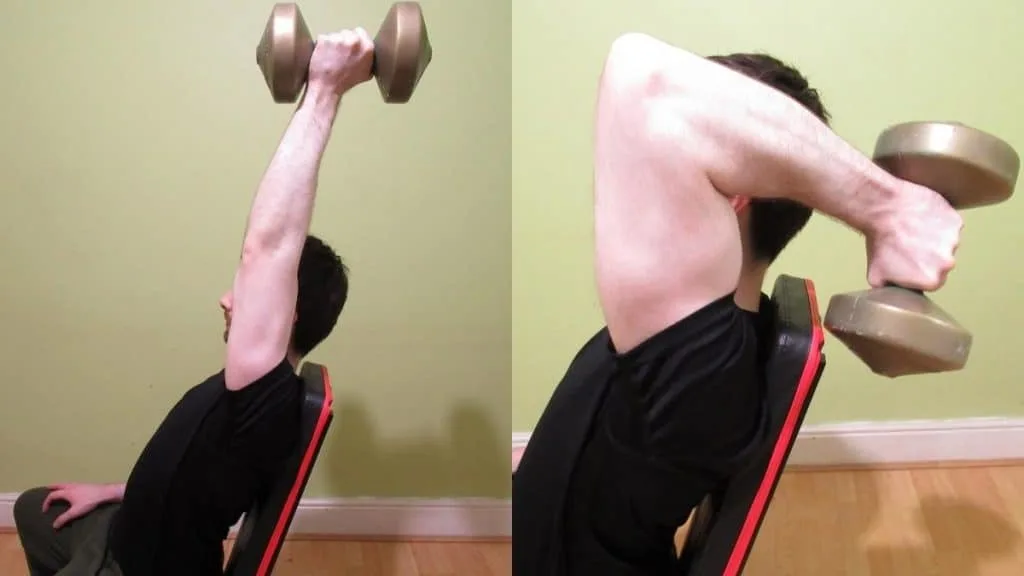
Seated one arm overhead dumbbell extensions help you to develop triceps that are symmetrical as well as muscular, an attribute that’s particularly important if you’re a competitive physique athlete.
The seated one arm overhead extension also helps to reduce strength imbalances between your triceps. This reduction, in turn, helps to prevent the bar from becoming lopsided during your compound presses, which further equalizes the work that your triceps are receiving.

